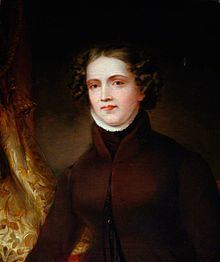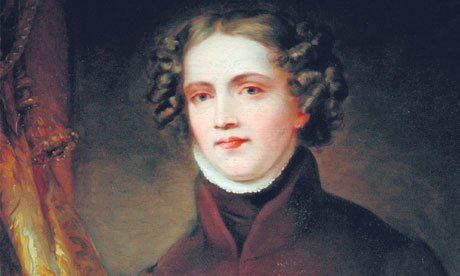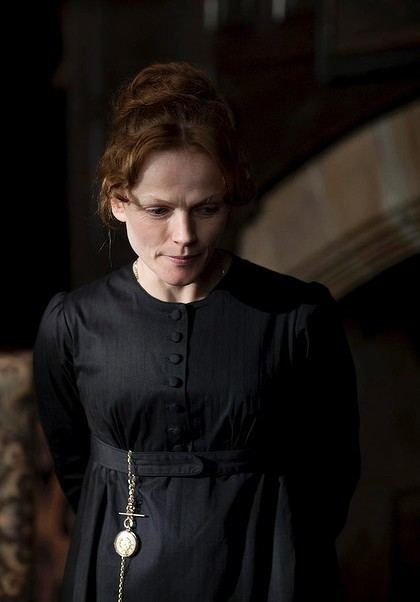Nationality British Occupation Landowner | Known for Diaries Name Anne Lister | |
Books I know my own heart, No Priest But Love, Miss Lister of Shibden Hall: Selected Letters (1800-1840) Siblings John Lister, Marian Lister, Samuel Lister People also search for Maxine Peake, James Kent, John Lister, Samuel Lister, Matt Hill, Jane English | ||
The secret diaries of miss anne lister lesbian movie trailer by leztuesday
Anne Lister (1791–1840) was a well-off Yorkshire landowner, diarist, mountaineer and traveller. Throughout her life she kept diaries which chronicled the details of her daily life, including her lesbian relationships, her financial concerns, her industrial activities and her work improving Shibden Hall. Her diaries contain more than 4,000,000 words and about a sixth of them—those concerning the intimate details of her romantic and sexual relationships—were written in code. The code, derived from a combination of algebra and Ancient Greek, was deciphered in the 1980s. Lister is often called "the first modern lesbian" for her clear self-knowledge and openly lesbian lifestyle. Called "Fred" by her lover and "Gentleman Jack" by Halifax residents, she suffered from harassment for her sexuality, and recognised her similarity to the Ladies of Llangollen, whom she visited.
Contents
- The secret diaries of miss anne lister lesbian movie trailer by leztuesday
- Lesbian movies the secret diaries of miss anne lister
- Life
- Death
- Diaries
- Research
- Historical recognition
- Popular culture
- Notable quotations
- References
Lesbian movies the secret diaries of miss anne lister
Life

Anne Lister was a rural gentlewoman who directed the renovation and landscaping of Shibden Hall, near Halifax in the West Riding of Yorkshire, which she had inherited from her uncle, James Lister.

Anne was the eldest daughter of Jeremy Lister (1753–1836) who as a young man in 1775 served with the British 10th Regiment of Foot in the Battles of Lexington and Concord in the American war of Independence. In August 1788 he married Rebecca Battle (1770–1817) of Welton in East Riding, Yorkshire. Their first child, John was born in 1789 but died the same year. Anne Lister was born in Halifax 3 April 1791. In 1793 the family moved to an estate named Skelfler House at Market Weighton. Skelfler was where the young Anne Lister would spend her earliest years. A second son, Samuel who would be a close friend to Anne, was born in 1793. The Listers actually had six children but only Anne and her younger sister Marian would survive to adulthood.

Between 1801 and 1805, Lister was educated at home by the Reverend George Skelding, the vicar of Market Weighton, and at the age of seven she was sent to a school run by a Mrs Hagues and a Mrs Chettle in Agnesgate, Ripon. On her visits to her aunt Anne and uncle James at Shibden Hall, the Misses Mellin gave her lessons. In 1804 Anne Lister was sent to the Manor House School in York (in the King's Manor buildings), where Anne would meet her first love, Eliza Raine (1791–1869). Eliza and her sister Jane were the very rich daughters of an East India Company surgeon in Madras, brought to Yorkshire after his death. Anne and Eliza met and shared a bedroom aged 13 at boarding school, but Anne was asked to leave after two years. She rejoined the school after Eliza had left. Eliza expected to live with Anne as an adult, but Anne began affairs with Isabella Norcliffe and Mariana Belcombe, day-pupils at the school. In despair and frustration Eliza became a patient at Clifton Asylum, run by Mariana's father Dr Belcombe. While being educated at home Lister developed an interest in classical literature. In a surviving letter to her aunt from 3 February 1803, a young Lister explains "My library is my greatest pleasure... The Grecian History had please me much.

Her wealth allowed her some measure of freedom to live as she pleased. She inherited the family estate on her aunt's death in 1836, Shibden Hall, but took charge of it from 1826, and from it drew a reasonable income (some of it from tenants).
In addition to income from agricultural tenancy, Lister's financial portfolio included properties in town, shares in the canal and railway industries, mining and stone quarries. Anne Lister used the income from this varied portfolio to finance her two passions; Shibden Hall and European travel.
Lister is described as having a "masculine appearance"; one of her lovers, Marianna Lawton (née Belcombe), was initially ashamed to be seen in public with her because her appearance was commented on. She dressed entirely in black and took part in many activities that were not perceived as the norm for gentlewomen, such as opening and owning a colliery. She was referred to as "Gentleman Jack" in some quarters. Lawton and Lister were lovers for several years, including a period during which Lawton was married and had her husband's permission.
Lister's subsequent affair with a wealthy heiress, Ann Walker, whom she met in 1832, was a story of local repute and her eventual marriage (without legal recognition) to Walker in 1834 was highly unusual. The couple lived together an Shibden Hall until Lister's death in 1840. Walker's fortune was used to improve Shibden Hall and the property's waterfall and lake. Lister renovated Shibden Hall quite significantly to her own design. In 1838 she added a Gothic tower to the main house, to serve as her private library. She also had a tunnel dug under the building which allowed the staff to move about without disturbing her.
In 1830 while travelling in France, Lister was the first woman to ascend Mont Perdu in the Pyrenees. In 1838, she came back to the Pyrenees with Walker and completed the first "official" ascent of the Vignemale (3,298 metres (10,820 ft)). In France she was known as Ann Lister or Lady Lister only for this accomplishment.
Death
Anne Lister died aged 49 of a fever at Koutais (now Kutaisi, Georgia) while travelling with Ann Walker. Walker, to whom ownership of Shibden Hall passed, had Lister's body embalmed and brought back to the UK, where she is buried in the parish church in Halifax, West Yorkshire. Ann Walker died in 1854 at her childhood home, Cliff Hill in Lightcliffe.
Throughout her life, Lister had a strong faith in the Anglican Church. Lister's family had a vault at the Halifax parish church where her remains were interred on 29 April 1841. Her tombstone was recently discovered after being covered by a floor in 1879. The current family tomb is at St Anne's Church, Southowram, where John Lister is buried; he was the first to attempt the translation of Anne Lister's diaries.
In her will Lister's estate was left to her paternal cousins but Ann Walker was given a life interest. After being declared insane, Walker spent some years in the care of Dr. Belcombe and, because of her mental state, was unable to make a valid will.
More than forty years after her death, while reporting on a dispute over the ownership of Shibden Hall, the Leeds Times stated 'Miss Lister's masculine singularities of character are still remembered'.
Diaries
During her life, Anne wrote a four-million-word diary. It began in 1806 as scraps of paper, recording in secret code parcels sent to and from Eliza Raine, and eventually became the 26 Quarto volumes ending at her death in 1840. In addition to her handwriting being incredibly difficult to decipher, around one-sixth of the diary is encrypted in a simple code she and Eliza had devised, combining the Greek alphabet, zodiac, punctuation and mathematical symbols, and it describes quite graphically her lesbian nature and affairs, as well as the tactics she used for seduction. The diaries also contain her thoughts on the weather, social events, national events and her business interests. The majority of her diary deals with her daily life, and not merely her lesbianism, and provides detailed information on social, political and economic events of the time.
The code used in her diaries was deciphered by the last inhabitant of Shibden Hall, John Lister (1847–1933) and a friend of his, Arthur Burrell. When the content of the secret passages was revealed, Burrell advised John Lister to burn all the diaries. Lister did not take this advice, but instead continued to hide Anne Lister's diaries behind a panel at Shibden Hall.
In 2011, Lister's diaries were added to the register UNESCO Memory of the World Programme. The register citation notes that, while a valuable account of the times, it was the 'comprehensive and painfully honest account of lesbian life and reflections on her nature, however, which have made these diaries unique. They have shaped and continue to shape the direction of UK Gender Studies and Women’s History.'
Research
Dorothy Thompson of Birmingham University Department of Modern History gained a £24,000 grant from the Economic and Social Research Council (ESRC) in 1985 to decode the diaries, and employed Patricia Hughes as Research Associate on a two-year contract from November 1986 to October 1988. As well as discovering the very first juvenile Lister diaries and decoding the other two Lister codes, Hughes wrote and published "Anne Lister's Secret Diary for 1817" (2006, Hues Books Ltd) and "The Early Life of Miss Anne Lister and the Curious Tale of Miss Eliza Raine" (2010 Hues Books Ltd). Both books make extensive use of other materials in the Anne Lister archives including letters, diaries and ancillary documents.
Author Helena Whitbread published some of the diaries in two volumes (one in 1988 and one in 1992). Their graphic nature meant at first they were believed by some to be a hoax, but documentary evidence has since established their authenticity. A biography by Jill Liddington appeared in 1994. In 2014 a conference was held at Shibden Hall which focused on Lister's life along with gender and sexuality in the nineteenth century.
Historical recognition
In 2016 Shibden Hall was relisted by Historic England.
Popular culture
In 1994 the first episode of the BBC Two series A Skirt Through History titled A Marriage featured Julia Ford as Anne Lister, and Sophie Thursfield as Marianna Belcombe.
In 2010, BBC Two broadcast a production based on Lister's life, The Secret Diaries of Miss Anne Lister, starring Maxine Peake as Lister. Revealing Anne Lister, a documentary featuring Sue Perkins, was broadcast on 31 May 2010 on BBC Two.
In 2012, on their second album, The Fragile, chamber folk duo O'Hooley & Tidow (Belinda O'Hooley and Heidi Tidow) released a song about Anne Lister, which is called Gentleman Jack.
In March 2017 an eight-part drama based on Lister's life was announced. Written by BAFTA winner Sally Wainwright, it will be a co-production between the BBC and HBO; filming will be in 2018. Wainwright has remarked that “Anne Lister is a gift to a dramatist... She is one of the most exuberant, thrilling and brilliant women in British history, and I can’t wait to celebrate her. Landowner, industrialist, traveler, mountaineer, scholar, would-be brain surgeon and prolific diarist…To bring Anne Lister to life on screen is the fulfillment of an ambition I’ve had for twenty years.” The series has been entitled Gentleman Jack and will star Suranne Jones as Anne Lister.
Notable quotations
"I love and only love the fairer sex and thus beloved by them in turn, my heart revolts from any love but theirs." – Anne Lister, Journals, 29 October 1820
"Yet my manners are certainly peculiar, not all masculine but rather softly gentleman-like. I know how to please this fair maiden of mine." – Anne Lister, Journals, 1820
